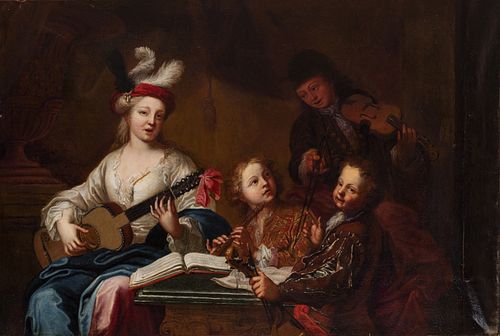Northern Italian school; circa 1700. "Musical evening". Oil on canvas. Relined.
Lot 89
About Seller
Setdart Auction House
Carrer Aragó 346
Barcelona
Spain
Setdart Subastas was born in 2004 and is currently the first online art auction in Spain with solidity, prestige and reliability guaranteed by our more than 60,000 users. Setdart has a young, dynamic and enterprising team ready to successfully manage the purchase and sale of art works through custom...Read more
Estimate:
EUR€9,000 - EUR€10,000
$9,677.42 - $10,752.69
Absentee vs Live bid
Two ways to bid:
- Leave a max absentee bid and the platform will bid on your behalf up to your maximum bid during the live auction.
- Bid live during the auction and your bids will be submitted real-time to the auctioneer.
Bid Increments
| Price | Bid Increment |
|---|---|
| EUR€0 | EUR€10 |
| EUR€200 | EUR€25 |
| EUR€500 | EUR€50 |
| EUR€1,000 | EUR€100 |
| EUR€3,000 | EUR€200 |
| EUR€5,000 | EUR€500 |
| EUR€10,000 | EUR€1,000 |
| EUR€20,000 | EUR€2,000 |
| EUR€50,000 | EUR€5,000 |
About Auction
By Setdart Auction House
Oct 20, 2021
Set Reminder
2021-10-20 07:30:00
2021-10-20 07:30:00
America/New_York
Bidsquare
Bidsquare : OLD MASTERS
https://www.bidsquare.com/auctions/setdart-auction-house/old-masters-7700
Setdart Auction House sofia@setdart.com
Setdart Auction House sofia@setdart.com
- Lot Description
Northern Italian school; circa 1700. "Musical evening". Oil on canvas. Relined. It has repainting and missing edges. It has damages caused by humidity. Size: 92 x 137 cm. The painting has an old extension located in the right area. The canvas shows a conversation, or rather an evening, between a group of people of different genders and ages, which may well represent a mother with her children and father. Inscribed in a neutral background of ochre tones, we can appreciate in the foreground the figures of the children on the right and the woman on the left. In the background, and portrayed with less precision, we can observe the presence of an adult male character, who holds a violin in his hands, directing the bow of the instrument towards the center of the composition. There is a table with an open book, showing sheet music. The active attitude of this person, who indicates to others what to do, invites the viewer to reflect on the relationship of the characters portrayed, questioning whether it is an exercise of pleasure, or a work activity. However, the woman's attire defines this question, since we can appreciate a large feather headdress, from which hang three pearls, as well as satin ornaments and other luxurious fabrics. The lady, who seems to be singing while holding a guitar, directs her gaze directly to the viewer, making him a participant in the scene, as well as the child who is located in the right area of the composition. This type of representation in which a group of people gathered around a table, although it is not this specific case, to chat and discuss, had a great reception as it reflected the customs of the evenings held by the upper class of the time. In this work the family representation linked to musical instruments, indicates the high position of the family, since only the upper classes could access to musical education. Which was highly valued, especially in the training of women of the time. It is worth mentioning that this painting reflects in its subject matter the tradition of paintings of modern moral customs, in which, on many occasions, the author mocked and showed in a satirical way the customs of the time.
- Shipping Info
-
In-house shipping available. Please inquire at admin@setdart.com.
-
- Buyer's Premium



 EUR
EUR CAD
CAD AUD
AUD GBP
GBP MXN
MXN HKD
HKD CNY
CNY MYR
MYR SEK
SEK SGD
SGD CHF
CHF THB
THB





